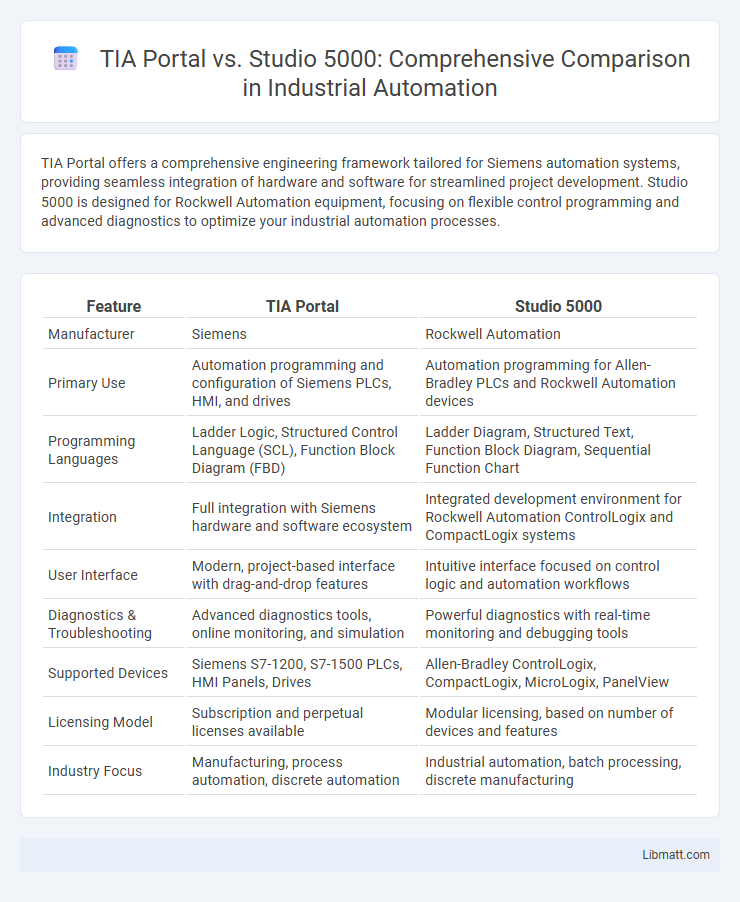TIA Portal offers a comprehensive engineering framework tailored for Siemens automation systems, providing seamless integration of hardware and software for streamlined project development. Studio 5000 is designed for Rockwell Automation equipment, focusing on flexible control programming and advanced diagnostics to optimize your industrial automation processes.
Table of Comparison
| Feature | TIA Portal | Studio 5000 |
|---|---|---|
| Manufacturer | Siemens | Rockwell Automation |
| Primary Use | Automation programming and configuration of Siemens PLCs, HMI, and drives | Automation programming for Allen-Bradley PLCs and Rockwell Automation devices |
| Programming Languages | Ladder Logic, Structured Control Language (SCL), Function Block Diagram (FBD) | Ladder Diagram, Structured Text, Function Block Diagram, Sequential Function Chart |
| Integration | Full integration with Siemens hardware and software ecosystem | Integrated development environment for Rockwell Automation ControlLogix and CompactLogix systems |
| User Interface | Modern, project-based interface with drag-and-drop features | Intuitive interface focused on control logic and automation workflows |
| Diagnostics & Troubleshooting | Advanced diagnostics tools, online monitoring, and simulation | Powerful diagnostics with real-time monitoring and debugging tools |
| Supported Devices | Siemens S7-1200, S7-1500 PLCs, HMI Panels, Drives | Allen-Bradley ControlLogix, CompactLogix, MicroLogix, PanelView |
| Licensing Model | Subscription and perpetual licenses available | Modular licensing, based on number of devices and features |
| Industry Focus | Manufacturing, process automation, discrete automation | Industrial automation, batch processing, discrete manufacturing |
Introduction to TIA Portal and Studio 5000
TIA Portal, developed by Siemens, is an integrated engineering framework designed for programming and configuring automation systems, offering seamless integration across PLCs, HMIs, and drives within a single interface. Studio 5000 by Rockwell Automation provides a comprehensive software platform tailored for programming Allen-Bradley controllers, emphasizing scalability and modular design for industrial control systems. Understanding the core functionalities of TIA Portal versus Studio 5000 helps optimize Your automation workflows based on the specific hardware ecosystem and project requirements.
User Interface and Usability Comparison
TIA Portal offers an intuitive user interface with a centralized workspace that integrates programming, configuring, and diagnostics, enhancing workflow efficiency for Siemens PLC users. Studio 5000 provides a modular interface tailored for Allen-Bradley controllers, emphasizing detailed tag management and structured programming with customizable workspace layouts. Users report faster navigation and reduced learning curves in TIA Portal due to its seamless tool integration, while Studio 5000 excels in advanced control applications with extensive project documentation features.
Hardware Compatibility and Support
TIA Portal offers extensive hardware compatibility, primarily supporting Siemens PLCs and automation devices, ensuring seamless integration within Siemens ecosystems. Studio 5000 is tailored for Allen-Bradley hardware, including ControlLogix and CompactLogix controllers, providing robust support for Rockwell Automation products. Your choice should align with the specific hardware brand used in your automation system to maximize compatibility and support efficiency.
Programming Languages and Flexibility
TIA Portal offers multiple programming languages including Ladder Logic, Function Block Diagram, and Structured Text, providing versatile options for various automation projects. Studio 5000 primarily supports Ladder Logic and Sequential Function Chart, focusing on Rockwell Automation's Logix controllers, which ensures seamless integration but may limit diverse language use. Your choice between TIA Portal and Studio 5000 should consider the programming flexibility you need for your automation environment.
Integrated Diagnostics and Troubleshooting
TIA Portal offers advanced integrated diagnostics with real-time error detection and detailed system diagnostics that streamline troubleshooting across Siemens automation devices. Studio 5000 provides contextual diagnostics with Allen-Bradley controllers and components, emphasizing real-time fault analysis and user-friendly interfaces for efficient troubleshooting. Both environments enhance maintenance efficiency by delivering comprehensive diagnostic data tailored to their respective hardware ecosystems.
Scalability and Project Management
TIA Portal offers extensive scalability with integrated tools tailored for Siemens automation systems, enabling seamless project management across small to large-scale industrial setups. Studio 5000 excels in handling complex Rockwell Automation environments, providing robust project version control and modular programming features that enhance scalability and streamline collaboration. Both platforms support efficient resource allocation and cross-functional team coordination, optimizing project workflows for diverse industrial applications.
Communication Protocols and Network Integration
TIA Portal supports a wide range of communication protocols including PROFINET, PROFIBUS, and Modbus TCP, enabling seamless integration within Siemens automation environments and third-party devices. Studio 5000 primarily utilizes Ethernet/IP and DeviceNet protocols, optimizing network integration for Allen-Bradley controllers and Rockwell Automation systems. Your choice between these platforms will depend on the specific network infrastructure and protocol compatibility required for your industrial automation projects.
Simulation and Testing Capabilities
TIA Portal offers robust simulation tools like PLCSIM and PLCSIM Advanced, enabling detailed virtual testing of Siemens PLC programs before deployment. Studio 5000 provides Logix Emulate, allowing you to simulate Rockwell Automation controllers with high fidelity for accurate testing and validation. Both platforms enhance your automation project by minimizing physical hardware dependency during development through effective simulation and debugging capabilities.
Licensing Models and Cost Considerations
TIA Portal offers flexible licensing options including perpetual licenses, subscriptions, and floating licenses tailored for scalable Siemens automation projects, helping you manage costs effectively based on project size. Studio 5000, primarily licensed through Rockwell Automation's annual or multi-year subscriptions, may incur higher upfront expenses but includes continuous software updates and support. Evaluating your project's duration and complexity ensures optimal cost-efficiency when choosing between these two platforms.
Industry Adoption and Community Support
TIA Portal dominates industries centered on manufacturing automation, with Siemens' extensive global presence driving widespread adoption and a large, active user community. Studio 5000 is preferred in North American and automotive sectors, supported by Rockwell Automation's strong network of certified partners and specialized forums. Your choice should consider the local industry preference and the availability of robust technical support and resources within each platform's community.
TIA Portal vs Studio 5000 Infographic

 libmatt.com
libmatt.com